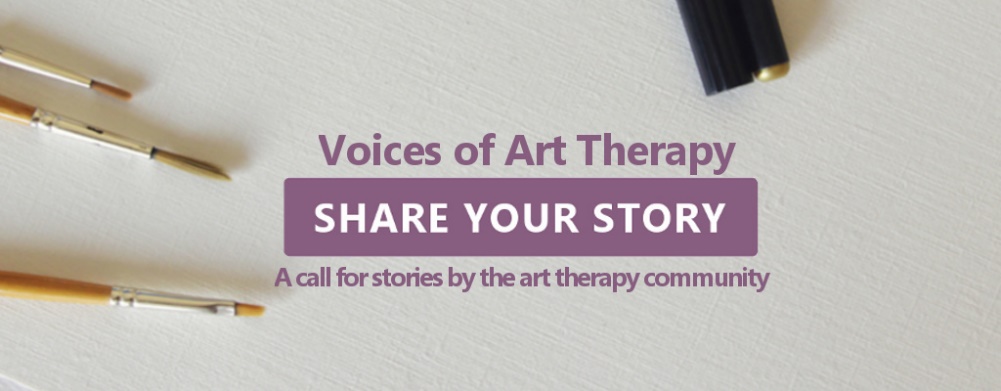By Kat Michel | April 12, 2018 | #WeAreArtTherapists
The therapeutic alliance between art therapist and client is the foundation for the clinical session, and it is through the quality and nature of this relationship that goals are set and achieved, and positive change occurs. A core part of this is the idea of trust: trust in the safety of the clinical space, trust in confidentiality, trust in a nonjudgmental approach to art making, and more. The following stories from Voices of Art Therapy highlight moments during which art therapists were able to meet clients at their levels, build rapport, and establish trust, all through the “simple” act of art making.
“The Case of Abby” by Mari Grande, LCAT, ATR-BC, LCSW
Abby is fragile, we cannot go very fast. She will “leave the room.” She tells me when she does this. I have to move slowly. She wants crayons; her voice changes, she becomes very young. I go along with her. I meet her; I sit with her on the floor, where she feels most at ease, even though she is 68 years old. She wants to tell me about her dreams. She had two, we decide to use art because she goes into her head, her thoughts swarm like flies and can take her places she can’t bear. She “knows” too much, she repeats too much. When she starts to draw her dreams she remembers more of them. She cannot make the image, just colors and lines, it is enough for her, and it is plenty for me. She wants to be near, she wants her mommy, she will never have her and she is angry. Art therapy for Abby is a way to connect, to me, to parts of her and to begin to develop trust not only with another person but also in a process, the creative process so vital to the philosophy of art therapy.
“Lighting the Journey: Remembering Why I Became an Art Therapist” by Kristin J. Riding, MA-AT, pursuing ATR
I had worked with many struggling adolescents when he arrived at the partial hospitalization program. I had many encounters where clients impacted my practice as an Art Therapist, but this one was different.
Michael arrived at our program right around Christmas time. I was already aware of him because of his assessment as well as adolescents who had already been in the program; but this I never told him, of course. Michael entered my group room and changed the way I think about life, therapy, being a human, and sharing my light with others.
This young man experienced a horrific and traumatic experience a little over one year ago. Since that time, he shut off the world and attempted suicide many times. He denied having feelings. He denied having a problem. He just did not believe life was worth living. He did not believe in anyone to help him; because who would want help when everyone was telling him that he was foolish and attention seeking. All I could offer him was the opportunity to be present, to sit in the mud with him, and to encourage the art to teach us both. Michael would scribble in a handmade journal, journal his thoughts for me to respond to, paint with watercolors, and to throw chalk across a life-size figure drawing. I wasn’t sure if the creative process was helping him. Still‒I encouraged him to take all of the junk in his mind and his body and place it elsewhere.
After two weeks together, Michael was feeling very low and depressed; stating he wanted to die. I was the only one Michael would talk too. I asked Michael to think of a light in his life that could encourage him to keep moving forward and what he could learn from this light during these dark moments.
Michael said: “You. You’re the light. You make the darkness bearable. You are real. You don’t give me any BS response. You care about me. You make me realize that life is worth living. You tell me to make art, even when I don’t want to. You don’t give up on me. You tell us to trust ourselves, to trust the art we make.”
Prior to this moment, I was internalizing all of these insecurities. “Am I even good enough to continue being an Art Therapist? Why can’t I figure out my niche with these groups? Am I even making a difference, I mean these teenagers are so stubborn.”
It was that feedback from Michael that brightened my own light. He reminded me of my humanness and to just make art. Most importantly, he helped me remember why I became an Art Therapist.
Michael left the program recently and though our group dynamic mourns the loss of such a significant individual, I understand that being my authentic self in a group of unique and “Please don’t change me, just understand me” teenagers is how I reach through; even if all we do is make art together.
How to Share Your Story
There are many ways to describe art therapy and often a story is a powerful way to share our work. We know these amazing stories because we experience them every day and have the honor of witnessing the impact of art therapy in people’s lives. Now it’s time to share those stories with the world.
Here are some tips for effective storytelling:
- Provide focus: Concentrate on one succinct story to allow readers to connect with the experience.
- Be visual: Compelling images draw readers in. Select artwork that sparks emotion and grabs your attention.
- Use real details: Quotes, sights, sounds, and events help make your story more tangible and relatable.
- Get personal: Focus your attention on the central figure of your story. Tap into human emotion, enabling readers to form a connection with him/her/them.

Please share this link with your colleagues! All art therapists are encouraged to participate!
